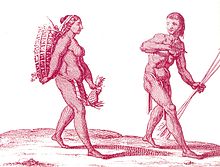User:90santi90/Woman the Gatherer

Woman the Gatherer is a theory developed by Sally Slocum. The theory was a direct critique on the Man the Hunter thesis proposed by Washburn and Lancaster. She first presented this work as an essay in Toward an Anthropology of Women. Slocum authored the work as a way to critique what she considered male bias in anthropology.
Background[edit]
In her introduction, Slocum analyzes what is accepted as proof, as well as closely examines the questions asked in anthropology. A quote reads, "There is a strong male bias in the questions asked, and the interpretations given. This critique is offered in hopes of transcending the male bias that limits our knowledge by limiting the questions we ask".[1]
Theory[edit]
Slocum starts her critique by mentioning the notion that "larger brains were selected for, making possible transmission of information concerned with tool making, and organizing cooperative hunting." [2] In response, Slocum contends that skills associated with hunting (coordination, endurance, good vision) are found equally in males and females. She writes "I have heard of no evidence to indicate that these skills are either carried on the Y chromosome, or are triggered into existence by the influence of the Y chromosome."[3] Slocum also asserts that larger brains developed because women had to deal with more complex social relationships. She writes, "The need to organize for feeding after weaning, learning to handle the more complex social-emotional bonds that were developing, the new skills and cultural inventions surrounding more extensive gathering-all would demand larger brains."[4]
Critique of Food Sharing[edit]
Slocum also critiques the idea that food-sharing developed because of hunting. Slocum explains, "As the period of infant dependency began to lengthen, the mothers would begin to increase the scope of their gathering to provide food for their still-dependent infants. The already strong primate mother-infant bond would begin to extend over a longer time period, and giving rise to the first sharing of food."[5] Slocum also critiques the male bias that women and children were dependent on males for food. She writes, "The females can usually gather enough to support themselves and their families. In these groups, gathering provides the major portion of the diet.",[6]
References[edit]
- ^ Warms, Richard L., McGee, Jon R. (2008). "Anthropological Theory: An Introductory History", p. 399-407. McGraw Hill Inc, New York
- ^ Warms, Richard L., McGee, Jon R. (2008). "Anthropological Theory: An Introductory History", p. 399-407. McGraw Hill Inc, New York
- ^ Warms, Richard L., McGee, Jon R. (2008). "Anthropological Theory: An Introductory History", p. 399-407. McGraw Hill Inc, New York
- ^ Warms, Richard L., McGee, Jon R. (2008). "Anthropological Theory: An Introductory History", p. 399-407. McGraw Hill Inc, New York
- ^ Warms, Richard L., McGee, Jon R. (2008). "Anthropological Theory: An Introductory History", p. 399-407. McGraw Hill Inc, New York
- ^ Warms, Richard L., McGee, Jon R. (2008). "Anthropological Theory: An Introductory History", p. 399-407. McGraw Hill Inc, New York
